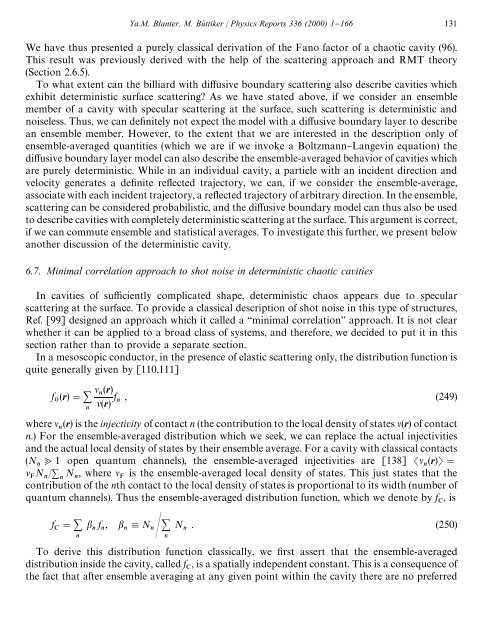shot noise in mesoscopic conductors - Low Temperature Laboratory
shot noise in mesoscopic conductors - Low Temperature Laboratory
shot noise in mesoscopic conductors - Low Temperature Laboratory
You also want an ePaper? Increase the reach of your titles
YUMPU automatically turns print PDFs into web optimized ePapers that Google loves.
Ya.M. Blanter, M. Bu( ttiker / Physics Reports 336 (2000) 1}166 131<br />
We have thus presented a purely classical derivation of the Fano factor of a chaotic cavity (96).<br />
This result was previously derived with the help of the scatter<strong>in</strong>g approach and RMT theory<br />
(Section 2.6.5).<br />
To what extent can the billiard with di!usive boundary scatter<strong>in</strong>g also describe cavities which<br />
exhibit determ<strong>in</strong>istic surface scatter<strong>in</strong>g? As we have stated above, if we consider an ensemble<br />
member of a cavity with specular scatter<strong>in</strong>g at the surface, such scatter<strong>in</strong>g is determ<strong>in</strong>istic and<br />
<strong>noise</strong>less. Thus, we can de"nitely not expect the model with a di!usive boundary layer to describe<br />
an ensemble member. However, to the extent that we are <strong>in</strong>terested <strong>in</strong> the description only of<br />
ensemble-averaged quantities (which we are if we <strong>in</strong>voke a Boltzmann}Langev<strong>in</strong> equation) the<br />
di!usive boundary layer model can also describe the ensemble-averaged behavior of cavities which<br />
are purely determ<strong>in</strong>istic. While <strong>in</strong> an <strong>in</strong>dividual cavity, a particle with an <strong>in</strong>cident direction and<br />
velocity generates a de"nite re#ected trajectory, we can, if we consider the ensemble-average,<br />
associate with each <strong>in</strong>cident trajectory, a re#ected trajectory of arbitrary direction. In the ensemble,<br />
scatter<strong>in</strong>g can be considered probabilistic, and the di!usive boundary model can thus also be used<br />
to describe cavities with completely determ<strong>in</strong>istic scatter<strong>in</strong>g at the surface. This argument is correct,<br />
if we can commute ensemble and statistical averages. To <strong>in</strong>vestigate this further, we present below<br />
another discussion of the determ<strong>in</strong>istic cavity.<br />
6.7. M<strong>in</strong>imal correlation approach to <strong>shot</strong> <strong>noise</strong> <strong>in</strong> determ<strong>in</strong>istic chaotic cavities<br />
In cavities of su$ciently complicated shape, determ<strong>in</strong>istic chaos appears due to specular<br />
scatter<strong>in</strong>g at the surface. To provide a classical description of <strong>shot</strong> <strong>noise</strong> <strong>in</strong> this type of structures,<br />
Ref. [99] designed an approach which it called a `m<strong>in</strong>imal correlationa approach. It is not clear<br />
whether it can be applied to a broad class of systems, and therefore, we decided to put it <strong>in</strong> this<br />
section rather than to provide a separate section.<br />
In a <strong>mesoscopic</strong> conductor, <strong>in</strong> the presence of elastic scatter<strong>in</strong>g only, the distribution function is<br />
quite generally given by [110,111]<br />
(r)<br />
f (r)" <br />
(r)<br />
<br />
f , (249)<br />
<br />
where (r) is the <strong>in</strong>jectivity of contact n (the contribution to the local density of states (r) of contact<br />
<br />
n.) For the ensemble-averaged distribution which we seek, we can replace the actual <strong>in</strong>jectivities<br />
and the actual local density of states by their ensemble average. For a cavity with classical contacts<br />
(N
















